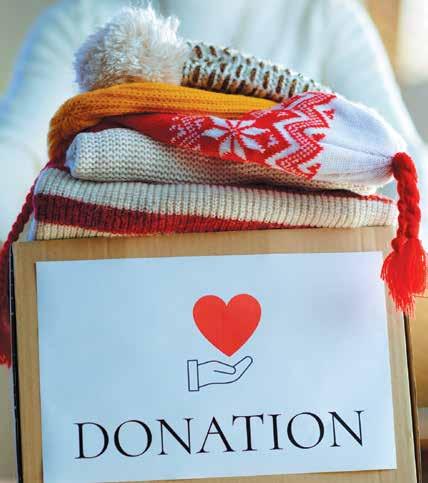
2 minute read
Clothing Donation Tips UNDERSTANDING WHERE
Secondhand Items Go
by Kelcie Ottoes
Advertisement
Donating Tips
Before donating to an organization, assess the quality of the item. “The rise in fast fashion means that consumers are choosing to purchase a higher volume of clothing overall, meaning more is ending up in donation bins,” says Erin Houston, co-founder of WearWell, an ethical and sustainable marketplace for clothing and other goods “But because fast fashion pieces are notoriously poorly constructed, that item that was worn only a few times might only last the next person a couple of wears before it begins to fall apart.”
If the piece is fast fashion, consider donating it directly to a textile recycler, provided it is not made of synthetic fibers. Otherwise, try to find a new home for the unwanted piece first. Host a clothing swap or post on a local buy-nothing page to find neighbors that need the items.
Look for entities that specify where the donated item will be redistributed. “With organizations like I Support The Girls [ISTG], a donor knows exactly where their donations are going,” says Dana Marlowe, ISTG founder and executive director. “We can handle the quality control ourselves and ensure that as little as possible ends up as waste or is recycled improperly. As a hyper-focused nonprofit that narrows in on gently used bras of all kinds, we don’t have to sort through every clothing and product type under the sun.”
If there isn’t a hyper-specific donation center for an item, consider one of the following options: n LOCAL THRIFT STORES AND SECONDHAND SHOPS resell gently used, wearable items. n ANIMAL SHELTERS take blankets, sheets and towels for kennels. n WOMEN’S SHELTERS accept gently used items, especially professional attire. n SCHOOLS need children’s jackets, hats, gloves and pants. n HOMELESS SHELTERS AND CHURCHES hold clothing drives to fulfill community needs. n VINTAGE STORES are ideal for items that are simply outdated. n NATIONAL ORGANIZATIONS like Goodwill or Salvation Army resell donations.
Most donation centers have guidelines to ensure they can use or redistribute the items. While dropping off clothes, don’t forget to browse the racks and buy an item or two to support the outlet.
Avoid roadside bins and overseas donations. These are often textile recycling companies that pose as charitable organizations, and wearable clothes are downcycled into rags, rather than re-worn.
Clothes sent overseas are often resold at bargain prices, but potentially at the cost of local manufacturers. Imported used clothing can also be a local environmental burden. In Ghana, the world’s largest importer of secondhand clothing, an estimated 40 percent is considered unsellable, and 70 percent of those items are illegally dumped, resulting in environmental damage to rivers and seas.
Certain items shouldn’t be donated and may need to be recycled or thrown out, such as clothing with tears, stains, odor, mold or dirt, as well as, for sanitary reasons, underwear, socks and worn-out shoes.
Kelcie Ottoes is a writer for sustainable businesses and contributor to Natural Awakenings








